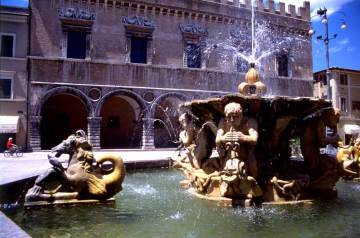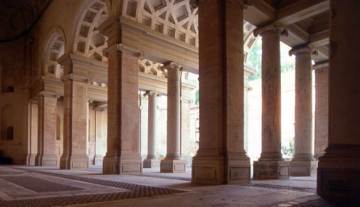|
The capital of the Marche's Pesaro e Urbino province, this appealing city is in turn an attractive seaside resort, a thriving fishing port and an important manufacturing centre. Its elegant broad streets have worthwhile sights to hold your attention and after a day on one of its uncrowded beaches, a fish supper by the sea is hard to beat.

At the heart of the city lies the wide main square, Piazza del Popolo. Sipping a cool drink from one of the smart bars flanking the piazza, admire the sea-horses and
tritons that decorate the sparkling fountain in the centre. Then let your eyes wander over the Palazzo Ducale that vies for your attention with the imperious post office
building. The clean-lined Renaissance palace, recently restored, was built in the middle of the 15th century by the ruling Sforza family. It now houses local government
offices and an exhibition space open to the public. Take a moment to walk into the imposing courtyard.
Leaving the square towards the sea along Via Rossini you'll find on your right the modest house where Italy's great opera composer Gioachino Rossini was born in 1792; it is now a small shrine to the composer. The annual Rossini Opera Festival in August has earned a
world-wide reputation for performing works from his large repertoire of bel canto operas.
Further down via Rossini stands the town's Cattedrale; step inside to see the remarkable mosaic floor uncovered in 2000. The beautiful early Christian work
dates from the 6th century and can be admired through glass panels set in the suspended modern floor. This vast work of art belongs to the same period as the magnificent Byzantine mosaics at Ravenna. In some
points you can also glimpse an even earlier and deeper mosaic floor dating from as early as the 4th century.
The city was once noted for its ceramic workshops that turned out the brightly painted earthenware known as majolica. In the Musei Civici (Civic Museums) in Piazza
Toschi Mosca (just off via Rossini) you can browse through one of Italy's finest collections of Renaissance and baroque pottery, much of it striking for its
spontaneous, almost modern, use of colour and design.
If crockery leaves you cold, the warmth of Giovanni Bellini's masterpiece, the Coronation of the Virgin in the adjoining Pinacoteca shouldn't. This large painting with a
series of smaller panels, originally created as an altarpiece, catches the eye with its sun-drenched colours and rounded, sculptural figures. The gallery also has a
large collection of interesting, if less important, Renaissance pictures.
The castle in the background of Bellini's painting is the Sforza family fortress at Gradara - it was Pesaro's ruling
lord, Costanzo Sforza, who commissioned the picture from the Venetian artist. If you're driving north on the motorway you will catch sight of it a few miles from
Pesaro - the view has hardly changed since the day Bellini painted it.
Centuries before the Sforza family ruled Pesaro, the city was already a thriving Roman colony, founded in 184 BC, probably on the foundations of an even older settlement
. For lost property from Roman Pisaurum visit the Museo Archeologico Oliveriano in via Mazza to the west of the main square.

Keep heading straight down via Rossini and you will eventually find yourself on the sea-front and looking at one of the city's most flamboyant buildings, the Villino
Ruggeri. This heavily stuccoed confection is one of the finest examples of the Italian Liberty style that swept the Adriatic Riviera at the turn of the 20th century.
Like most Italian beaches, the 3 km strand here is laid out with serried ranks of umbrellas and deck chairs but it is rarely overcrowded. For a more secluded beach with
green hills as a backdrop, make for Baia Flaminia just to the north of the centre. As well as sections with all the gear where you have to pay, there are also free
stretches of public beach. You'll also find free, uncluttered public beaches just south of the town on the SS16 road towards Fano.
|